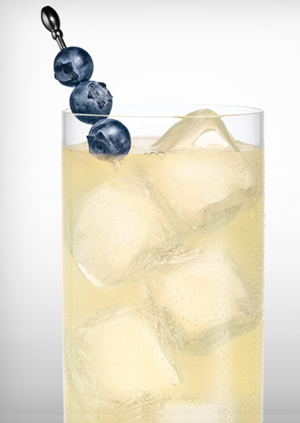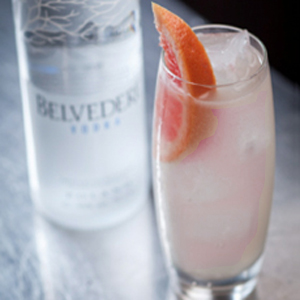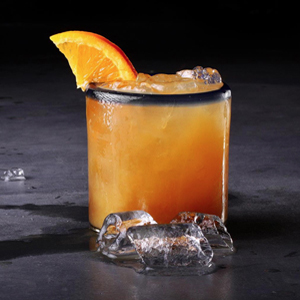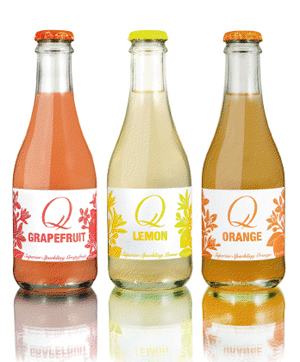 |
 |
Cool down with a Lemon Cooler: fizzy Lemon Q and vodka. Photo courtesy Smirnoff. |
| WHAT IT IS: High quality, low sugar mixers and soft drinks. |
| WHY IT’S DIFFERENT: All natural ingredients of the highest quality, organic agave sweetener instead of high fructose corn syrup, and elegant fizz. |
WHY WE LOVE IT: They’re “gourmet mixers.” |
| WHERE TO BUY IT: Check the store locator on QDrinks.com. |
|

Make your Grapefruit Fizz stand out with Q Grapefruit. Photo courtesy Belvedere Vodka.

You’ll love the taste of tequila mixed with Q Orange.
Photo courtesy Peligroso Tequila.
|
|
Q Drinks: Sophisticated Mixers & Soft Drinks
Back in 2006, a wonderful thing happened. A young man in Brooklyn happened to notice the nutrition label on the bottle of big-name tonic water served with his gin and tonic. He read the calories, and some ingredients that were not anywhere as fine as his top shelf gin. He became a man with a mission: to make an artisan tonic water as good as the gin.
Q Tonic Water changed the way that the tony-palate crowd thought about tonic water. Q Tonic had less sugar, and the sugar was real—not high fructose corn syrup. It enhanced the cocktail, allowing the spirit to shine.
Cocktail connoisseurs loved it, mixologists at elegant bars, haute boites and top restaurants loved it; and with all that love the line has grown Q-fold. There are now sparkling Ginger, Grapefruit, Lemon, Kola, and Orange to make anybody’s mixed drink better. Or to serve as a delicious adult soft drink when one isn’t having any (or any more) liquor.
 Three of the Q family of better mixers. Photo courtesy Q Drinks. Three of the Q family of better mixers. Photo courtesy Q Drinks.
Gourmet Mixers or Superior Sodas?
Whether for an elegant mixer or an adult soft drink, these clean, crisp, artisan-crafted beverages use the best ingredients the company can find. Organic agave comes from the Mexican countryside, quinine from the slopes of the Peruvian Andes, ginger from the fields of Southeast Asia, and salt from the Himalayas.
Instead of an overly sweetened American-style soda, the subtle sweetness of organic agave enables the true flavor of the soda to soar.
Where To Find Q Drinks
Q Drinks are sold at fine retailers nationwide. For more information and a store locator, visit QDrinks.com.
And the next time you’re invited to a party, bring a couple of four-bottle carriers for your host.
— Karen Hochman
Continue below, to the history of carbonated beverages.
|
| |
|
|
The History Of Carbonated Beverages
Today’s carbonated beverages owe everything to Joseph Priestley. Back in 1767, the British chemist discovered how to carbonate water, making a drink similar to the naturally carbonated mineral spring waters that doctors of the day thought had curative properties.
A decade and a half later, a Swiss watchmaker named Jacob Schweppe read about Priestley’s discovery and tinkered until he invented an artificial mineral water making machine.
Doctors soon prescribed the carbonated water for a variety of ailments. But there wasn't a great way to get the fizzy water to patients until Samuel Fahnestock invented (or at least got the patent for) the soda fountain in 1819.
- 1767: Joseph Priestley discovers how to carbonate water, by suspending a bowl of water above a beer vat—a process known as air blanketing.
- 1783: Jacob Schweppe invents a machine to artificially carbonate water. He called it the Geneva Apparatus.
- 1798: The term "soda water” is coined for carbonated water, although the drink contained no soda (sodium bicarbonate, or baking soda) but carbon dioxide.
- 1810: The first U.S. patent is issued for the mass manufacture of “imitation mineral waters,” to Simons and Rundell of Charleston, South Carolina.
- 1819: The “soda fountain” is patented by Samuel Fahnestock of Lancaster, Pennsylvania. It enabled store owners to sell the newly-invented, mass-produced soda water by the glass. The original intent was to to bring to the public the [alleged] healing powers and health benefits of the imitation mineral water. Others subsequently improved on the taps and spigots. This equipment really helped to popularize soda water.
- 1835: The first bottled soda water is sold in the U.S.
- 1836: New York City has 626 different soda fountains.
- 1850: A manual hand-and-foot-operated filling and corking device is first used to bottle soda water.
- 1851: The original ginger ale is created in Ireland. (See 1907)
- 1858: G.D. Dows of Boston invents and operated the first ornate, marble soda fountain. He changed the fountain in his brother’s store to create a fountain that combined the soda, syrups and ice shaver into a single apparatus of wood, white marble, and decorative metals. As the concept expanded, some giant, ornately designed wall temples offered up to 300 flavors.
- 1874: Robert McCay Green, operator of a soda fountain at Philadelphia’s Franklin Institute, creates the first ice cream soda (more).
|
|
- 1876: Root beer is mass produced for public sale for the first time
- 1881: The first cola-flavored beverage is introduced.
- 1883: James Tufts of Boston patents the Arctic soda fountain and goes on to become a major soda fountain manufacturer.
- 1885: Charles Aderton invents Dr. Pepper in Waco, Texas.
- 1886: Dr. John S. Pemberton, a pharmacist, invents Coca-Cola in Atlanta, Georgia (more).
- 1892: William Painter of Baltimore invents the crown bottle cap.
- 1898: Pepsi-Cola is invented by Caleb Bradham in New Bern, North Carolina.
- 1899 The U.S. Patent Office issues the first patent for a glass blowing machine.
- 1903: Doctor Heisinger patents the front service fountain.
- 1907: John McLauglin invents modern ginger ale, Canada Dry, in Toronto, in two varieties. The golden variety (rarely found today) is golden in color and has much more ginger flavor. The dry version is what we recognize today as modern ginger ale, pale in color with a mellow ginger flavor.
- 1911: There are 100,000 soda fountains in the U.S.
- 1920: The U.S. Census reports that the U.S. has more than 5,000 soda bottlers.
- 1923: Six-pack soft drink cartons called Hom-Paks are created.
- 1929: The Howdy Company debuts its new drink, Bib-Label Lithiated Lemon-Lime Sodas. They later changed the name to the slightly catchier 7 Up.
- 1934: Silkscreening (applied color label) is first used on soft drink bottles. The coloring is baked onto the face of the bottle
- 1952: The first diet soft drink sold. It’s called No-Cal Beverage. No-Cal, sweetened with saccharine, remained a popular brand for many years.
- 1957: Aluminum cans first used for soda
- 1965: Soft drinks in cans dispensed from vending machines.
- 1971: High Fructose Corn Syrup is invented by Dr. Yoshiyuki Takasaki at the Agency of Industrial Science and Technology of Ministry of International Trade and Industry of Japan. Prior attempts in the U.S. were unsuccessful. HFCS was rapidly introduced to many processed foods and soft drinks in the U.S. from about 1975 to 1985.
- 1973: The PET (Polyethylene Tere-phthalate) plastic bottle is created.
- 1977: The U.S. Government imposes tariffs on imported sugar, raising the price and leading more companies to consider HFCS.
- 1984: Coke and Pepsi replace sugar with High Fructose Corn Syrup.
- Around 2000: The artisan soda movement begins. Tired with HFCS and artificial flavors, soda connoisseurs like Fizzy Lizzy, GuS and Izze start their own small production companies.
Thanks to Q Drinks for much of this information. |
Do you have friends who would enjoy THE NIBBLE?
Click here to send them an invitation to sign up for their own copy. |
© Copyright 2004-
2024
Lifestyle Direct, Inc. All rights reserved. All information contained herein is subject to change at any time without notice. All details must be directly confirmed with manufacturers, service establishments and other third parties. The material in this webzine may not be reproduced, distributed, transmitted, cached, or otherwise used, except with the prior written permission of Lifestyle Direct, Inc. |
|

|
 |